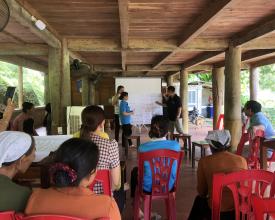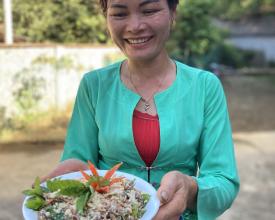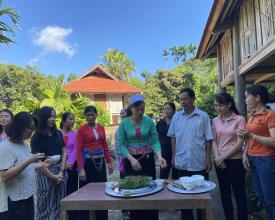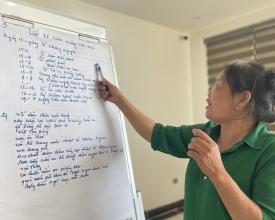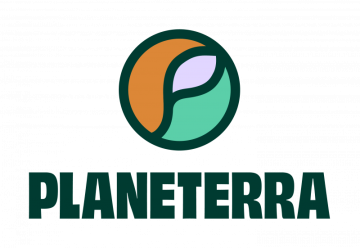
Product development for conservation areas with a focus on the community aspect
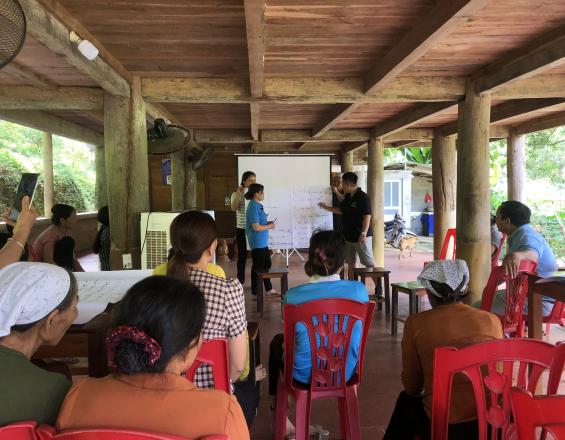
Community tourism can bring vast opportunities to communities living in and around protected areas. However, to thrive in the tourism sector, having natural and cultural resources that people can visit is not enough. Before talking about product development, it is crucial to understand two things: how the communities feel towards tourism, are they keen to work in the sector? and what is the current state of tourism in the locality?
This information can be obtained through surveys and observation. Once it is certain that the majority of community members are eager to work in tourism, the next step is to determine what training they need for product development.
In the case of the communities in Cuc Phuong National Park and Van Long Nature Reserve, the training provided focused on Ecotourism products & itinerary development, Health & Safety and Marketing. With this training, communities were able to develop touristic products to highlight their natural and cultural resources.
Context
Challenges addressed
-
There was little to none community tourism existing in both selected PAs, making it hard for capacity building for communities in a short timeframe. Among households being interviewed, only 3.2% and 1.5% of the households in Cuc Phuong NP and Van Long NR respectively made the majority of their livelihood through tourism pre-COVID.
-
Due to little community tourism practice, local communities also lack good infrastructure to provide travellers with a comfortable stay.
-
Despite a high percentage of respondents interested in learning new tourism skills (>70%) and diversifying their income (>80%) via tourism, people are still hesitant to engage in tourism initiatives without initial support.
-
With the main labour force between 36 and 65 years old (65-67%), dedicated to agriculture / forestry (58-80% of total household income), training participants are mostly middle-aged and above and have a limited ability to grasp modern knowledge.
Location
Process
Summary of the process
Through training courses (BB1) the “local champions” were identified. They play an important role in leading this initiative and being an example for other community members. In developing tour itineraries, those ‘local champions’ were the main members of their community who took part in the process and delivered the tour (BB2). Finally, when the itineraries were finalised, product testing was necessary for feedback and adjustment (BB3).
Building Blocks
Contextualised training content
-
The project was designed with predefined training content in 3 topics: (i) Health & Safety; (ii) Itinerary and Product Development; (iii) Marketing & Promotion, intended for community tourism entrepreneurs, individuals interested in working in tourism in the PAs and buffer zones, PA management and other personnel involved in PA management.
-
After conducting a baseline survey to understand the general local context and main actors in the community, the pre-designed training content was contextualised to fit with the main audience of the training workshops.
-
Different stakeholders have incompatible learning ability. Therefore, the training content was simplified with separated content for communities and for households / individuals who want to dive deeper in the topics.
-
Contextualisation also helps in bringing the knowledge closer to the participants.
-
As young people go to work in the daytime, most participants of the training workshops were middle-aged. A conventional training method, which is one-way communication, does not work in this case. A facilitation planning in detail was made to make sure everyone feels engaged in the training. Some methods which were used include: group discussion, resource mapping, small games with scores and prizes, etc.
-
Enabling factors
Local community members are introduced to community tourism, have an overview of basic skills needed to develop community tourism in the context of protected areas. For those who do not plan to engage in tourism soon, the training provides a perspective for community development so that they can confidently raise concerns about their community’s well-being and benefits if there is a private investor coming in the community.
Lesson learned
When it comes to training in the community, a more interactive approach to create two-way dialogues and dynamics is needed. It was clearly observed that when given more chances to talk and a safe space to speak their mind, people are more likely to engage and take ownership of their initiatives. For example, when asked to map out their community’s resources available to offer tourists, one of the villages drew a map of their community with a clear vision of who-offers-what. Additionally, although the next step was not part of the training nor required outcome, the same villagers actively came up with their own action plan to create a safe atmosphere for tourists to enjoy the village’s beauty.
Encouragement of Product Ownership
-
During the training, many exercises were designed for the local community’s engagement. This is also a good way to get information from local people about their community. One of the exercises in tour itinerary development training encouraged participants to plan a full-day tour incorporating remarkable landscapes and food within their local area. However, it must be noted that the participants might have different views on what ‘remarkable’ or ‘beautiful’ is.
-
Training workshops also offered a good opportunity to identify ‘local champions’ who willingly initiate the delivery of tourism services and products within their communities. An assessment of infrastructure conditions and strengths / unique features was conducted to see how their stories feed into the overall theme / routes of the itineraries (majority of which was built upon the inputs of the training participants).
-
Not only the excursion activity but the storytelling was also important in delivering / conveying the message to customers. The training participants / ‘local champions’ were asked to create an outline of what they want to introduce to the guests.
-
Complete tour itineraries were adjusted, finalised and ready for testing.
Enabling factors
The initially designed itineraries feature both conservation work of the PA and the community. However, the residents' knowledge of the conservation side was not sufficient for tour guidance. Therefore, the focus was shifted to the community aspect of the tour itineraries. This approach allows visitors to learn about the life of local communities in harmony with nature in the PAs while highlighting the conservation work at the grassroots level. The community members are also more confident in telling their own story from their perspective.
Lesson learned
Most participants were still hesitant to engage in tourism initiatives without initial support in finance. In this case, having local champions who proactively showed their interest in initiating something new in the community really helped. Oftentimes, they might already have other livelihood tools, or the household’s finances are taken care of by their children or their spouse. It is those local champions who will play an important role in defining / shaping tourism in their community and being an example for other community members.
Product Refinement and Testing
After the training was completed and the tour itineraries were designed, community members at Cuc Phuong National Park and Van Long Nature Reserve were ready to put their newly acquired skills to the test.
Instead of hosting familisation trips with tour operators, organising pilot excursions with real visitors would create more meaningful and practical impacts for the communities. By hosting these pilot excursions, community members would have the opportunity to be exposed to different markets and to be able to practise their activities in real-life circumstances.
In that sense, two immersive itineraries were proposed, targeting both international and domestic audiences residing in Hanoi who are incentivised to pay a 50% package rate as a donation for the communities in the protected areas and contribute to their development.
Enabling factors
As the local champions are mostly new to tourism, it takes time for them to get used to the concept, understand what community tourism really means and start learning basic skills to welcome tourists. Even when the tour itineraries were designed and looked good on paper, it does not mean that the tour is ready for the market. Bringing in tour operators in this early stage can do more harm than good. Therefore, test trips allowed product feedback and skill improvement before introducing them to the market.
Lesson learned
In Van Long, the visitors were impressed with the hospitality of the local people, and appreciated the training provided to the local communities by the Project. Alongside the highlights, some improvements were also pointed out. For instance, additional or feasible experiences can be expanded when the local hosts are more familiar with welcoming guests; or the timing and route of the boat ride can be adapted depending on the season and visitors.
In Cuc Phuong, Khanh villagers have been welcoming guests trekking from the Bong centre of the Park for a long time. Therefore, it took them little time to be able to organise the new experience, which is the cooking class in combination with a hiking experience. As the itinerary was designed to reduce the reliance of the village on the Park’s tourism, the route where the hiking and vegetable picking is conducted lies outside of the Park’s territory.
Impacts
-
03 training courses with the content contextualised according to actual local assets and knowledge were provided to 05 selected villages
-
Product Development training: 193 participants
-
Health & Safety training: 183 participants
-
Marketing & Promotion training: 138 participants
-
-
04 new tour itineraries were designed based on the inputs gathered during product development training with local communities, in which 02 itineraries were put to test
-
One learning trip and 03 test trips with a total of 10 visitors were organised in Van Long and Cuc Phuong, directly benefiting 12 service providers with total revenue of 451.00 USD. During the pandemic, they did not receive any guests (thus, no revenue from tourism).
Beneficiaries
The residents of 5 selected villages in and around Cuc Phuong National Park and Van Long Nature Reserve
